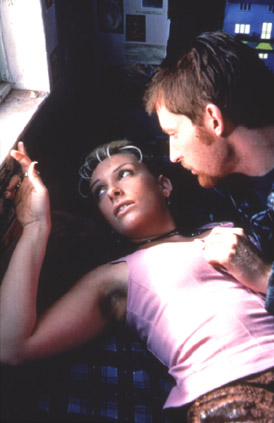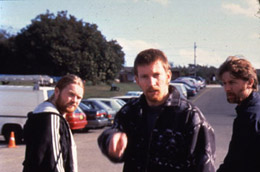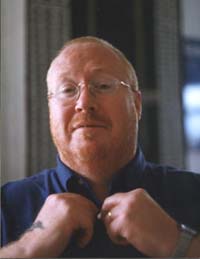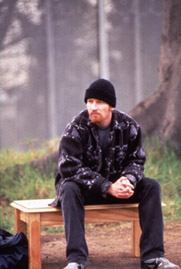The Interiors of FearRino Breebaart snaps and chats with UNSW film-graduate and director, Rowan Woods, about his confronting feature film The Boys.
 "Every design choice we made came either from homework and research or by playing an au contraire game with an expected, standard choice. Like the car. You'd think they've got a scary shark car, but hang on, the brother is such a dropkick, he couldn't even afford such a car, maybe it's the mother's car. The scariest option is always the most banal, or the least scary in terms of stereotyping. The other contender was an early-80s souped-up Cortina with mags and stuff, and then the station wagon with the roof racks: plain, safety yellow there's no comparison. We went for the plausible and logical."
"Every design choice we made came either from homework and research or by playing an au contraire game with an expected, standard choice. Like the car. You'd think they've got a scary shark car, but hang on, the brother is such a dropkick, he couldn't even afford such a car, maybe it's the mother's car. The scariest option is always the most banal, or the least scary in terms of stereotyping. The other contender was an early-80s souped-up Cortina with mags and stuff, and then the station wagon with the roof racks: plain, safety yellow there's no comparison. We went for the plausible and logical."
Rowan's past is in short films, of which more than fifteen bear his name as director. With producer Robert Connolly and Stephen Sewell, he spent about two and a half years developing the original play by Gordon Graham. "Stephen started from scratch with the script, so we had the same landscape of characters, but the structure and a lot of the story elements were now completely different. He writes these incredible cause and effect stories, where if you take a piece out of the jigsaw puzzle then the whole puzzle falls apart."
 "I think one of the problems with Australian films is the need to explain and provide answers and meaning, like in many American films there is this need to resolve and conclude. For me, resolution is a fucking good ending that resolves the story in a truthful, logical way whilst providing bigger question marks about the cinematic world just endured. People go into the story, it feels like a documentary, and once they're in that space, the story can start to manipulate their feelings of tension or contentment. As a director, if you don't deliver first of all the real atmospheres and secondly (but more importantly) the increase in the pressure cooker that is the Sprague household, then you're not delivering on the story, and not delivering philosophically on the nature of the material either." Rowan has made The Boys work entirely in that uncomfortable place in the mind which wants to leave but cannot turn away.
"I think one of the problems with Australian films is the need to explain and provide answers and meaning, like in many American films there is this need to resolve and conclude. For me, resolution is a fucking good ending that resolves the story in a truthful, logical way whilst providing bigger question marks about the cinematic world just endured. People go into the story, it feels like a documentary, and once they're in that space, the story can start to manipulate their feelings of tension or contentment. As a director, if you don't deliver first of all the real atmospheres and secondly (but more importantly) the increase in the pressure cooker that is the Sprague household, then you're not delivering on the story, and not delivering philosophically on the nature of the material either." Rowan has made The Boys work entirely in that uncomfortable place in the mind which wants to leave but cannot turn away.
 "Every design choice we made came either from homework and research or by playing an au contraire game with an expected, standard choice. Like the car. You'd think they've got a scary shark car, but hang on, the brother is such a dropkick, he couldn't even afford such a car, maybe it's the mother's car. The scariest option is always the most banal, or the least scary in terms of stereotyping. The other contender was an early-80s souped-up Cortina with mags and stuff, and then the station wagon with the roof racks: plain, safety yellow there's no comparison. We went for the plausible and logical."
"Every design choice we made came either from homework and research or by playing an au contraire game with an expected, standard choice. Like the car. You'd think they've got a scary shark car, but hang on, the brother is such a dropkick, he couldn't even afford such a car, maybe it's the mother's car. The scariest option is always the most banal, or the least scary in terms of stereotyping. The other contender was an early-80s souped-up Cortina with mags and stuff, and then the station wagon with the roof racks: plain, safety yellow there's no comparison. We went for the plausible and logical."
 "I don't have a PC problem with violence on the screen, but in this case, if the viewer is to focus uncompromisingly on the story, and take it to its logical extension, then you have to leave the crime out. There's a lot of subtexts and explanatory givens in the story: there's sexual inadequacy, poor communication, drugs and alcohol, a hint of a problem between mother and son (possibly abuse), bad economic conditions all thrown into the mix. But as for answers, we were all clear from the start that we weren't going to be taking a judgemental stance. It's not just inappropriate to provide false answers, it'd be a dumb story move, because as soon as we were seen to be answering questions for the audience about this very serious violence, the imaginative struggle would be halted, their intelligence would be insulted. We'd be dead meat as story tellers. So we sussed things out philosophically before anything else, realised that we didn't have any questions so what right do we have to provide obvious answers."
"I don't have a PC problem with violence on the screen, but in this case, if the viewer is to focus uncompromisingly on the story, and take it to its logical extension, then you have to leave the crime out. There's a lot of subtexts and explanatory givens in the story: there's sexual inadequacy, poor communication, drugs and alcohol, a hint of a problem between mother and son (possibly abuse), bad economic conditions all thrown into the mix. But as for answers, we were all clear from the start that we weren't going to be taking a judgemental stance. It's not just inappropriate to provide false answers, it'd be a dumb story move, because as soon as we were seen to be answering questions for the audience about this very serious violence, the imaginative struggle would be halted, their intelligence would be insulted. We'd be dead meat as story tellers. So we sussed things out philosophically before anything else, realised that we didn't have any questions so what right do we have to provide obvious answers."
 "The question of cinematic entertainment is simple, and I think the visceral interpretation is probably the best: do you want to go into the screen for the spectacle, the colour and the lights, or for the reality that is suddenly compelling, which rivets you for the whole duration? There are fundamental aspects to the way an audience responds in that darkened space: firstly with the willingness to suspend disbelief and move into the world of the screen, and secondly, when they do that, to let the ride keep them there and affect them emotionally. This makes the visceral experience all the more realistic and suspenseful: If the visceral aspect of the experience is working for you, then afterwards you can talk about it or tell someone else to go, and you can start to discuss the issues if there are issues to be thrown up, or talk about what a fucking great ride it was, regardless of the issues."
"The question of cinematic entertainment is simple, and I think the visceral interpretation is probably the best: do you want to go into the screen for the spectacle, the colour and the lights, or for the reality that is suddenly compelling, which rivets you for the whole duration? There are fundamental aspects to the way an audience responds in that darkened space: firstly with the willingness to suspend disbelief and move into the world of the screen, and secondly, when they do that, to let the ride keep them there and affect them emotionally. This makes the visceral experience all the more realistic and suspenseful: If the visceral aspect of the experience is working for you, then afterwards you can talk about it or tell someone else to go, and you can start to discuss the issues if there are issues to be thrown up, or talk about what a fucking great ride it was, regardless of the issues."